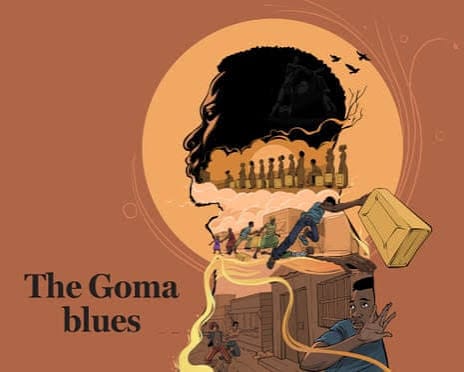In the eastern Congolese city of Goma, life continues under the long shadow of conflict. The streets hum with the uneasy rhythm of survival — markets reopen after nights of shelling, and children play in alleys that echo both laughter and fear.
For decades, this region, rich in minerals yet burdened by violence, has witnessed the rise and fall of armed groups, the displacement of millions, and a cycle of insecurity that seems unending.
While the world’s attention shifts elsewhere, artists like Edizon Musavuli use their talent to make sure that Goma’s pain — and its resilience — are not forgotten.
Wall Africa Journal (WAJ) reached Edizon Musavuli, a visual artist living in Goma, to hear the story behind the powerful drawings that have recently captured global attention.
A Voice Through the Pencil
“I am Edizon Musavuli, a visual artist,” he begins, speaking softly yet firmly.
“For the past few years, I’ve been creating illustrations and videos, and occasionally I do photography for fun, but my main focus is visual art as an illustrator and a draftsman. I live and work in Goma.”
His art, detailed and deeply human, blends hyper-realism with emotional truth. Through sketches and digital compositions, he captures the silent suffering, strength, and endurance of ordinary Congolese citizens — the mothers waiting in queues for food, the displaced families searching for home, and the children growing up amid uncertainty.
Musavuli’s recent works have been exhibited in France and Goma, drawing attention not only for their aesthetic beauty but also for their raw honesty.
“In most of my drawings,” he says
“I express what I see around me. I draw social life. Through my illustrations and hyper-realistic paintings, I speak about everyday life, about what I see and feel. I tell the stories I witness — what people say, what they feel, a kind of social snapshot of the daily life of a Congolese person, or simply, a human being.”
Goma: A City of Strength Amid Occupation
Goma has lived through nearly three decades of instability. Since the 1990s, armed movements — some locally rooted, others supported from outside — have turned the region into one of the most militarized zones in Africa. Today, much of North Kivu remains under threat from rebel groups such as the M23, leaving communities in a state of uncertainty and fear.
For Musavuli, this situation is not new — but it is exhausting.
“The current situation in Goma isn’t entirely surprising,” he reflects.
For thirty years, we’ve lived in a region marked by instability in the east of the country. We’re simply trying to adapt to yet another reality that’s been forced upon us, one that has fallen over our lives once again.
He pauses, then adds:
“The situation in Congo today is the outcome of many years without genuine peace. We’re living through the consequences of rebellions, armed groups, and, above all, decades of disastrous governance. The people of Kivu have few alternatives — they survive through it all. That’s what I do too.”
Survival, for him, takes the form of creation.
Art becomes resistance — not through weapons or slogans, but through pencils and paint.
Art as Freedom and Witness
In a place where speaking out can bring danger, drawing becomes a safer — yet still risky — form of expression.
Musavuli explains why he prefers to share his thoughts through writing rather than on video:
“Sorry but I won’t be comfortable doing a video in the local context,” he told WAJ. “It’s already a bit risky doing interviews as I’m doing for international media, so I prefer the text for now, as it’s about the current occupation.”
For him, art is both shield and voice.
“Art, for me, is the ultimate form of expression,” he says. “I don’t think I have another. It’s how I share my thoughts and convey messages, personal or social. That’s where I find my freedom.”
Every line he draws, every face he sketches, carries the unspoken words of thousands who cannot safely speak. His work challenges indifference — both local and global — reminding audiences that the crisis in eastern Congo is not an abstract political issue, but a lived human tragedy.
“If I have a message to the world,” he continues, “it is one of awareness, of information. It’s simply to make people aware, to remind them that life exists beyond their own world. Perhaps I am just one voice among many, a simple artist who cannot stay silent.”
“Expression Is the First Act When All Else Turns Dark”
Those words — “Expression is the first act when all else turns dark” — encapsulate Musavuli’s philosophy.
In a time when hope feels distant, expression itself becomes an act of resistance. His art, born in hardship, speaks louder than any political statement: it demands attention, compassion, and justice.
In Goma, where uncertainty defines daily life, artists like Edizon Musavuli are not only chroniclers of pain — they are also keepers of dignity.
Through his pencil, he restores humanity to stories too often buried under headlines of war.
And as the world scrolls past fleeting images of conflict, Edizon’s art stands still, urging us to look again — and to listen.



